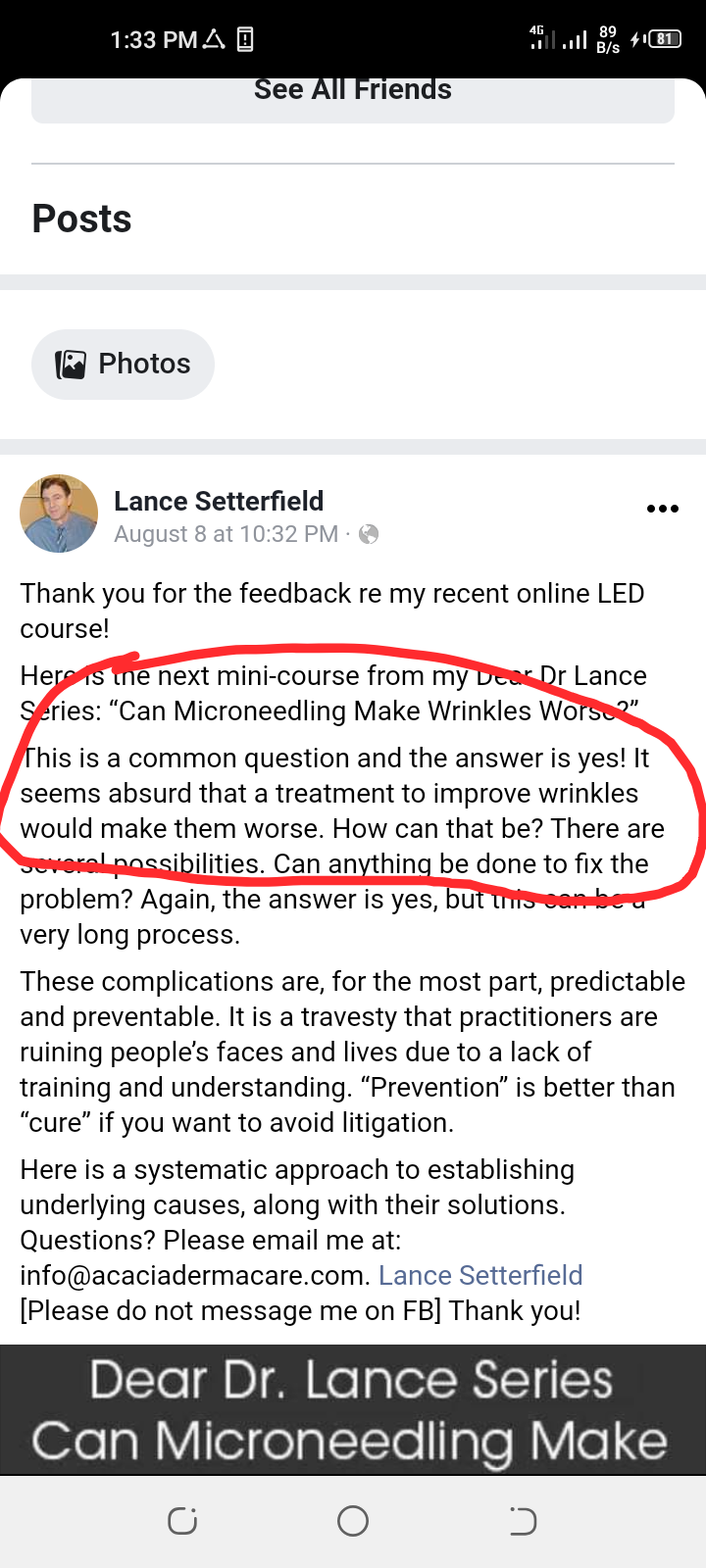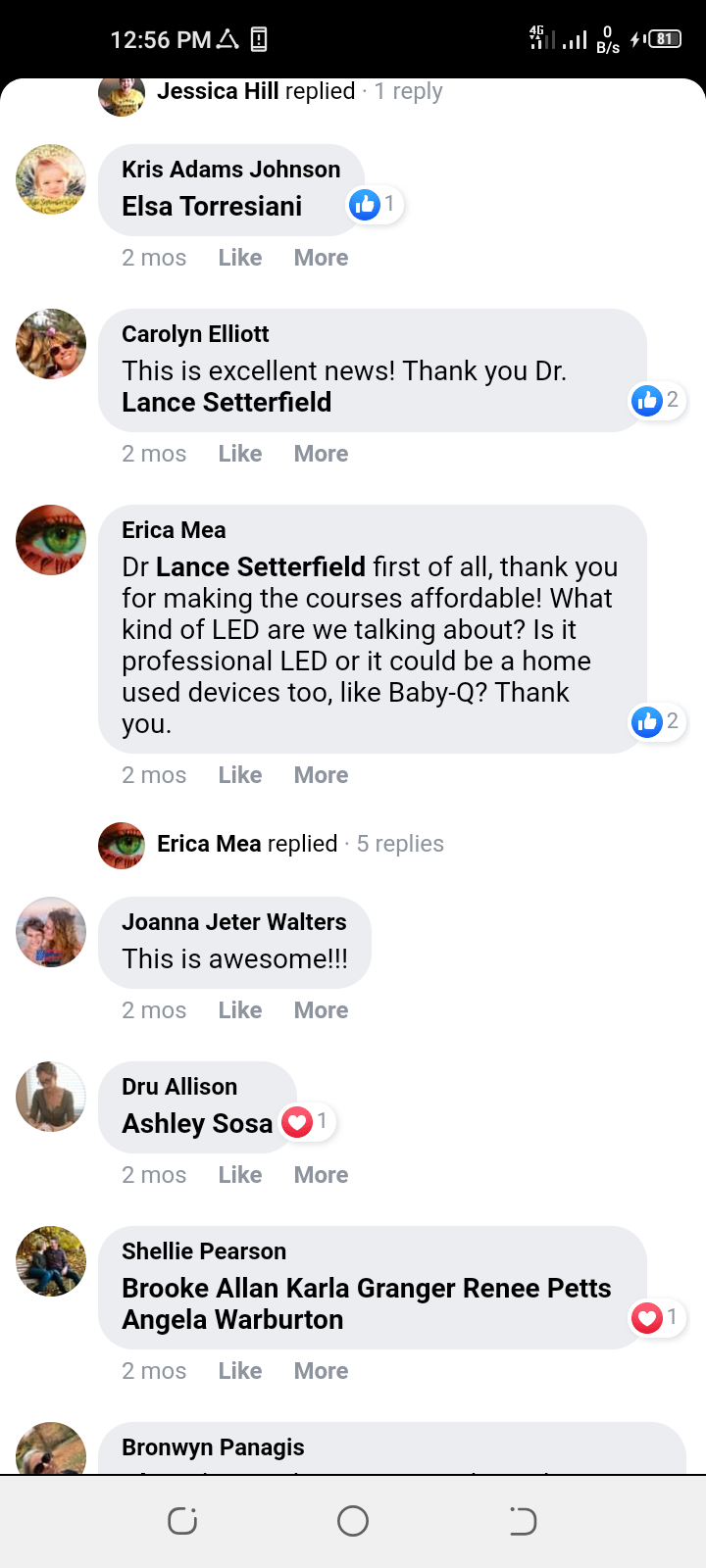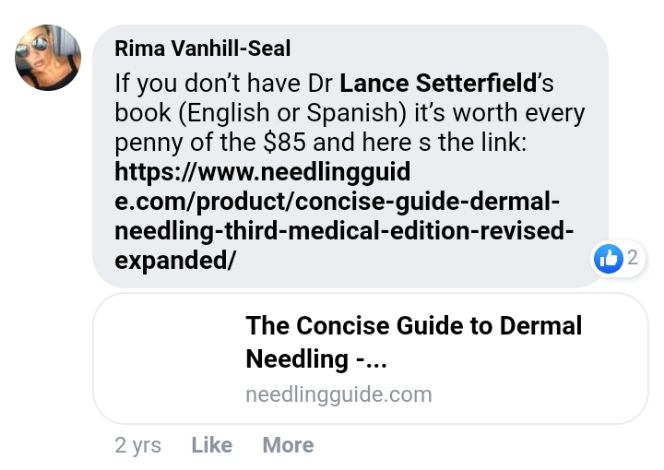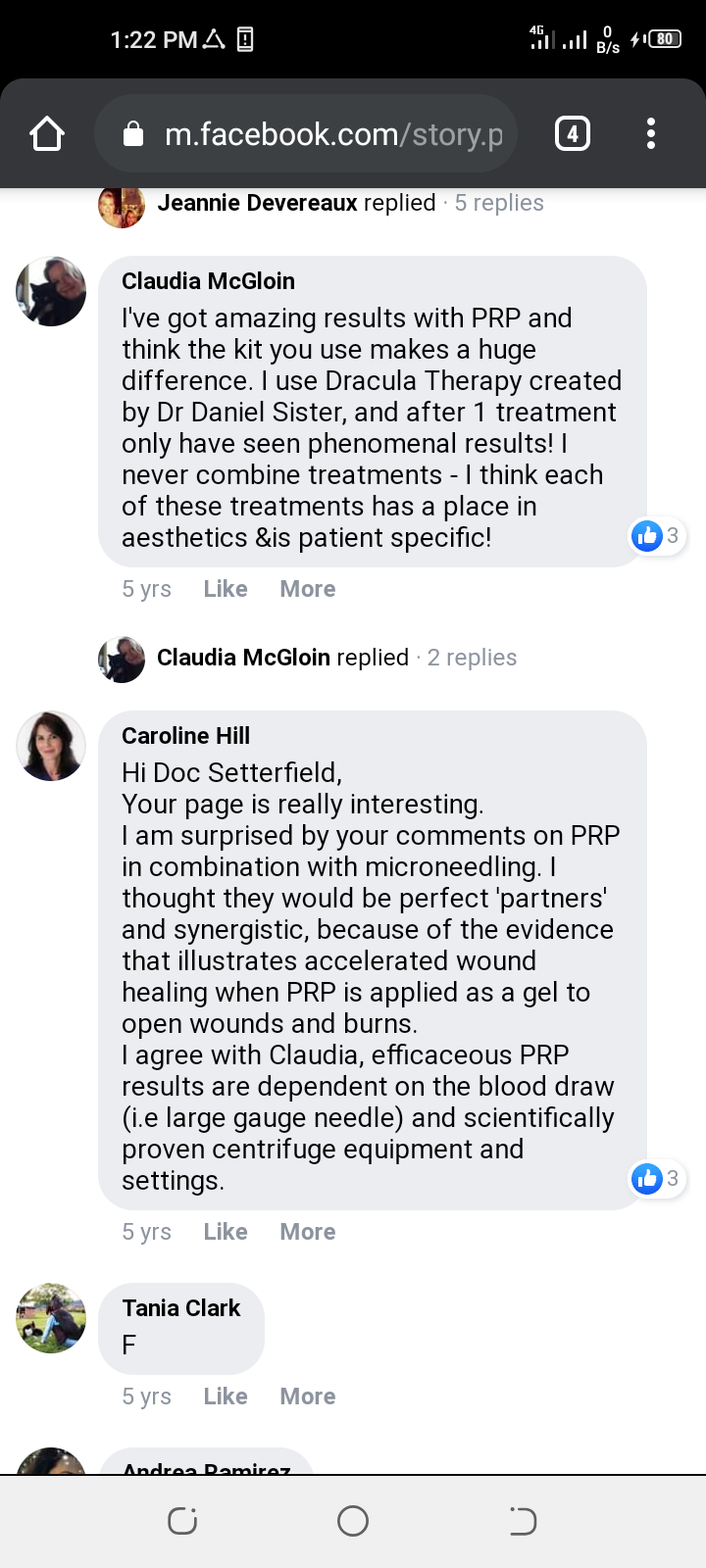1 hour ago, yepitsmewee said:Micro, the laser cuts tissue you without causing damage to any surrounding tissues. You'd glue it together with adhesive.
There is still a scar after this. I've read the procedure. It is an ablative nonetheless even if it's not as intense as other lasers. The incisions heal with scars(fibrosis) not regenerated tissue.
4 hours ago, yepitsmewee said:The laser byDwayne Miller? I emailed him and he said it was scarless.
He's lying bro, do your research(it's even called a near scarless technique because of its microscarring). That's all I'll say, if you want to go for it then I wish you the very best.
Ablatives burn tissue and cause scars, you could be as precise as you want, the scars will still form.
http://bib-pubdb1.desy.de/record/307498/files/ooi130043.pdf%3Fsubformat%3Dpdfa&ved=2ahUKEwicmdOWidnrAhU4VBUIHWh0AUI4MhAWMAB6BAgCEAE&usg=AOvVaw1FLVjjmsvzZEYLkjHTHhb 0" rel="external nofollow"> https://www.google.com/url?sa=t&source=web&rct=j&url=http://bib-pubdb1.desy.de/record/307498/files/ooi130043.pdf%3Fsubformat%3Dpdfa&ved=2ahUKEwicmdOWidnrAhU4VBUIHWh0AUI4MhAWMAB6BAgCEAE&usg=AOvVaw1FLVjjmsvzZEYLkjHTHhb0
That's a paper on his device with his name on it, do a quick search of "scar" and tell me what you find.
8 hours ago, David4bay said:He's lying bro, do your research(it's even called a near scarless technique because of its microscarring). That's all I'll say, if you want to go for it then I wish you the very best.
Ablatives burn tissue and cause scars, you could be as precise as you want, the scars will still form.
http://bib-pubdb1.desy.de/record/307498/files/ooi130043.pdf%3Fsubformat%3Dpdfa&ved=2ahUKEwicmdOWidnrAhU4VBUIHWh0AUI4MhAWMAB6BAgCEAE&usg=AOvVaw1FLVjjmsvzZEYLkjHTHhb 0" rel="external nofollow"> https://www.google.com/url?sa=t&source=web&rct=j&url=http://bib-pubdb1.desy.de/record/307498/files/ooi130043.pdf%3Fsubformat%3Dpdfa&ved=2ahUKEwicmdOWidnrAhU4VBUIHWh0AUI4MhAWMAB6BAgCEAE&usg=AOvVaw1FLVjjmsvzZEYLkjHTHhb0
That's a paper on his device with his name on it, do a quick search of "scar" and tell me what you find.
Yes
hi , i've been following this topic without posting for years now but i would like to know if theorically technology such as elastagen or sunogel could be used on wrinkles such as dynamic forehead lines.
I know microcoring is supposed to be targeted as a wrinkles improvement device even if i don't see how its going to be superior result wise to regular microneedling but could a wrinkles be "excised" then the elastagen or sunogel gel be used in the wound to create a wrinkle free area?
thanks and i would appreciate if a more knowledgable member than me could provide me with an answer on the subject. good luck to all
6 hours ago, copetillirope said:hi , i've been following this topic without posting for years now but i would like to know if theorically technology such as elastagen or sunogel could be used on wrinkles such as dynamic forehead lines.
I know microcoring is supposed to be targeted as a wrinkles improvement device even if i don't see how its going to be superior result wise to regular microneedling but could a wrinkles be "excised" then the elastagen or sunogel gel be used in the wound to create a wrinkle free area?
thanks and i would appreciate if a more knowledgable member than me could provide me with an answer on the subject. good luck to all
Sunogel isn't even a product yet and may not come out anytime soon if ever, Elastagen is a filler-like implant that repairs wounds - saying this, I don't think anyone here has the capacity to assure you it fixes or will fix anything outside of stretch marks or to act as sutures on compromised organs and skin. Microcoring unlike microneedling extracts the tissues of the skin, done fractionally, a percentage of skin can be removed without scarring so as to enable skin tightening in all directions, it is the only one advertised as an anti-wrinkle device.
Sunogel is a dextran based hydrogel(made mostly of water) that is biocompatible with living tissue, enough not to trigger an immune response against it but recruit a cell environment that will lead to the regeneration pathway in an organism. Sounds good, but the clinical product have gone silent for years as other hydrogels have ( sericin hydrogel, silk hydrogel, etc).
It would be wonderful if all these people working on pro-regenerative scaffolds could work together, to test maybe a mix of a hydrogel and tripoelastin membrane, put the hydrogel on a wound bed and seal it with tripoelastin, but science isn't what it used to be as more regulations means each product will stay in a long line with years in preclinical trials.
Microcoring should be out hopefully next year so you'll know for sure. Elastagen may be 2 years away from what I've read here, Sunogel is not known to still be in development. The website is still active. And Dr Guoming Sun's twitter account is still posting things on regeneration from time to time.
I do have a question... would Elastagen be able to heal a tissue graft without scarring? I'm confused on what it does.
The Hydrogels have not gone silent. Gemstone Biotherapeutics who claimed scarless healing with their Hydrogel with a pig just finished their human trials in May 2020. Another Chinese company also just publish in May 2020 about an injectable Hydrogel made of silk. Listed here: https://onlinelibrary.wiley.com/doi/abs/10.1002/adhm.202070029 .
"Elastagen's pipeline includes an injectable dermo-esthetic product in clinical proof-of-concept studies; a product for atrophic scars and stretch marks in clinical safety studies, and wound sealants and products for scar revision and wound healing in preclinical development". When will their sealant and scar revision come out?
7 hours ago, yepitsmewee said:I do have a question... would Elastagen be able to heal a tissue graft without scarring? I'm confused on what it does.
The Hydrogels have not gone silent. Gemstone Biotherapeutics who claimed scarless healing with their Hydrogel with a pig just finished their human trials in May 2020. Another Chinese company also just publish in May 2020 about an injectable Hydrogel made of silk. Listed here: https://onlinelibrary.wiley.com/doi/abs/10.1002/adhm.202070029 .
This might be the last reply I'll give you as I'm not sure if you're deliberately convincing yourself of things which aren't the case.
1. There have been journal papers for hydrogels all the way back from 2004(reasonably even older). There is a wide gap between an article being released by a group of scientists and a company interested in funding the product into a product by pushing it through clinical trials. The paper you posted is still another one of "hydrogel x does y" and that's that.
2. The company Gemstone Biotherapeutics like all other clinical trial companies that I know of for hydrogels have gone silent, and the "human trials" from 2019 have not been updated since 2019. The estimated end date is May 2020, not that they've completed clinical trials.
We could say maybe it's due to the Coronavirus, they're still silent all the same, their website even fails to load some sections.
3. Again, I don't know if you're trying to convince yourself of things which aren't the case. Where in my post did I say Elastagen doesn't heal wounds?
I said it's application has been stated as an implant to assist wound recovery but nobody knows if it can or will work for your wrinkles. How is that difficult to understand?
Even the other startup, LifeSproutbio that have hydrogels that solve volume issues from fat loss don't have a hydrogel product yet, the pipeline is in clinical trials like the rest, they only have their filler component out in the market.
I'm telling you all these so you don't fall into the sway of some con-man, as you thought a PIRL was a Scarless excision laser earlier and was told it was without having done your homework.
Till anything comes out you'll have to wait and review the tech from it's source. Hopefully Elastagen can be used for what you want, only Weiss can give you a conclusive answer.
I check in on this thread every year or so. One thing I think people may be overlooking is the advancements being made in artificial general intelligence. Some reputable scientists are predicting it could be as close as 2033. It's actually quite possible that AI may be the key to making scarless healing a reality in the near future.
Without AI I think scarless healing is at least 10 years away. Probably more like 20 or 30. And it's definitely something I think will almost certainly exist in the next 40-50 years.
People on this thread need to have realistic expectations. A lot of these biotech companies and FDA devices are just scams to take desperate peoples money. Lasers are a perfect example of this.
There is definitely hope in the not so distant future though.
2 hours ago, bucketofrice said:I check in on this thread every year or so. One thing I think people may be overlooking is the advancements being made in artificial general intelligence. Some reputable scientists are predicting it could be as close as 2033. It's actually quite possible that AI may be the key to making scarless healing a reality in the near future.
Without AI I think scarless healing is at least 10 years away. Probably more like 20 or 30. And it's definitely something I think will almost certainly exist in the next 40-50 years.
People on this thread need to have realistic expectations. A lot of these biotech companies and FDA devices are just scams to take desperate peoples money. Lasers are a perfect example of this.
There is definitely hope in the not so distant future though.
I agree A.I may be fundamental to the more advanced forms of scarless healing, like the printing and creation of complex human intercellular matrixes for bone, skin, nerves and other soft tissue regeneration.
It's even fairly safe to say if A.I were advanced enough scientists could run simulations of thousands of bio-active compounds, enzymes, co-enzymes and materials that could aid the breakdown of scars and redirect it's remodelling into healthy tissue. A sufficiently advanced A.I could take in all those 20+ years of clinical data and turn out so many different combinations of materials that would take human researchers centuries if not more to even consider. It could even run its own trials in short amounts of times. And if such an A.I oversaw the medical field, it could monitor every step in progress a patient is healing and correct any deviations from healing with scar tissue to regenerated skin by monitoring growth factors and the cell environment of damaged or revised tissue. Not to talk of gene editing with such an A.I.
But like all tech right now, it's in its infancy. People would rather much complain of why their tax money is going into it if it can't solve their immediate problems.
It's more likely to me that we may have to physically deal with scarring long before the other technologies are produced, that's why I respect and look forward to procedures like microcoring, Elastagen, and whatever else is on the pipeline in the near future. It's just a shame that we live in times where science is moving back and forth, from advancement to pushback by the FDA, the public or animal rights groups. To be fair safety is important, but most times a technology that's safe and could save millions of lives is stuck in clinical trial hell before the people behind it either give up, lose funding or change projects, taking only extreme situations before they're greenlit for release. Or if fortunate enough, catch the eye of a large Pharma company.
@David4bayNo I'm not trying to convince myself, I am simply trying to shed light all these companies where abouts. I appreciate you updating me on the PIRL laser. As for Gemstone, I spoke with their founder and they did complete their trials. He said: "We are in the process of winding down the Gemstone Operations and working with John Hopkins to move the technology back into the lab where we collectively believe it has a better chance of success. With more focused R&D and access to grant funding, the Hopkins team will be well positioned to exploit the value of the technology and move it to better commercial applicability. Re the limited initial trials that have taken place, I can only say that while there were promising results, there is simply not enough data to make any serious claims at this stage. Hope this helps." I was told from other employees that the company ran out of funding which is why they are moving the technology back to Hopkins.
I also spoke with Tony Weiss, formerly the owner of Elastagen, "These technologies are progressing well. You might have read that Elastagen successfully transitioned its products and those in the pipeline to Allergen, and that ALLERGEN WAS RECENTLY BOUGHT BY ABBVIE. These are fine companies and as a result, the patent portfolio continues to expand with ongoing development. There will more publications later this year and next year, including clinical assessments."
Most of this information is stuff that we already know, but I tried to reach out to these company leaders to see if anything else could be found out.
10 hours ago, bucketofrice said:I check in on this thread every year or so. One thing I think people may be overlooking is the advancements being made in artificial general intelligence. Some reputable scientists are predicting it could be as close as 2033. It's actually quite possible that AI may be the key to making scarless healing a reality in the near future.
Without AI I think scarless healing is at least 10 years away. Probably more like 20 or 30. And it's definitely something I think will almost certainly exist in the next 40-50 years.
People on this thread need to have realistic expectations. A lot of these biotech companies and FDA devices are just scams to take desperate peoples money. Lasers are a perfect example of this.
There is definitely hope in the not so distant future though.
but they say it will hit the market in 2021
On 9/11/2020 at 1:24 AM, yepitsmewee said:@David4bayNo I'm not trying to convince myself, I am simply trying to shed light all these companies where abouts. I appreciate you updating me on the PIRL laser. As for Gemstone, I spoke with their founder and they did complete their trials. He said: "We are in the process of winding down the Gemstone Operations and working with John Hopkins to move the technology back into the lab where we collectively believe it has a better chance of success. With more focused R&D and access to grant funding, the Hopkins team will be well positioned to exploit the value of the technology and move it to better commercial applicability. Re the limited initial trials that have taken place, I can only say that while there were promising results, there is simply not enough data to make any serious claims at this stage. Hope this helps." I was told from other employees that the company ran out of funding which is why they are moving the technology back to Hopkins.
I also spoke with Tony Weiss, formerly the owner of Elastagen, "These technologies are progressing well. You might have read that Elastagen successfully transitioned its products and those in the pipeline to Allergen, and that ALLERGEN WAS RECENTLY BOUGHT BY ABBVIE. These are fine companies and as a result, the patent portfolio continues to expand with ongoing development. There will more publications later this year and next year, including clinical assessments."
Most of this information is stuff that we already know, but I tried to reach out to these company leaders to see if anything else could be found out.
Thanks for the update on Gemstone. I noted that Sharon Gerecht andGuoming Sun collaborated together at John Hopkins University as far back as 2010. Do you have any feedback on Sunogel?
On 9/2/2020 at 11:50 PM, David4bay said:In the hands of someone inexperienced any procedure is a risk, that was what I meant. You can make scars worse if you microneedle without giving your skin enough time to heal properly and remodel it's collagen or using overly aggressive needling techniques - which brings in the DermaPen vs Dermaroller comparison, you have less precision and uneven penetration moreso using a Dermaroller especially over facial contours.
I would argue quite the opposite. The DermPen is likely to give you less control than a DermaRoller. Due to the speed of the Motor it is easy to create far more punctures in less time and the would healing cascade is amplified. This amplification is not easy to measure based on the duration of treatment and erthemaas the end point. The inflammatory component is often greater in electronic devices, hence a higher incidence of complications which were not evident with rollers. This includes subtle scaring which appear as enlarged pores or worsening of wrinkles and post inflammatory hyperpigmentation. For further information i would recommend reading Dr Lance Settlefield's book on the subject (The Conise Guide to Dermal Needling).
51 minutes ago, OddMarket said:I would argue quite the opposite. The DermPen is likely to give you less control than a DermaRoller. Due to the speed of the Motor it is easy to create far more punctures in less time and the would healing cascade is amplified. This amplification is not easy to measure based on the duration of treatment and erthemaas the end point. The inflammatory component is often greater in electronic devices, hence a higher incidence of complications which were not evident with rollers. This includes subtle scaring which appear as enlarged pores or worsening of wrinkles and post inflammatory hyperpigmentation. For further information i would recommend reading Dr Lance Settlefield's book on the subject (The Conise Guide to Dermal Needling).
I've heard of the book and it's affiliated with a company that sells beauty products whose margins were being affected by dermarollers.
They are safe, have been used for over 60 years, and the "control" you say is less with a DermaPen is erroneous due to the fact that it's adjustable in both speed of penetration and length of needles, skillful use is what should be encouraged.
The penetration of microneedles trigger growth factors and macrophages more so than fibroblasts, these remodel the skin and rejuvenates it. And the swelling from inflammation is not prolonged nor needs to be with good aftercare. Though not all skin conditions warrant microneedling and some not immediately till some lesions have resolved and may not pose a risk to the process.
Mechanical devices to treat the skin have brought the best results so far.
7 hours ago, David4bay said:I've heard of the book and it's affiliated with a company that sells beauty products whose margins were being affected by dermarollers.
They are safe, have been used for over 60 years, and the "control" you say is less with a DermaPen is erroneous due to the fact that it's adjustable in both speed of penetration and length of needles, skillful use is what should be encouraged.
The penetration of microneedles trigger growth factors and macrophages more so than fibroblasts, these remodel the skin and rejuvenates it. And the swelling from inflammation is not prolonged nor needs to be with good aftercare. Though not all skin conditions warrant microneedling and some not immediately till some lesions have resolved and may not pose a risk to the process.
Mechanical devices to treat the skin have brought the best results so far.
The pens do allow you to adjust the speed and depth. But the Pens work at such a speed thats its easy to traumatise the skin. Bleeding is not a desired end point. The rollers on the other hand are easier to balance in that regard. The general consensus is that less is more. Dr Letterfields book covers the science of derma needling and makes no endorsements. He covers both the pros and cons of electronic devices and rollers without reference to any particular brand or product. Its a well written medical encyclopaedia on the subject.
17 hours ago, OddMarket said:The pens do allow you to adjust the speed and depth. But the Pens work at such a speed that™s it™s easy to traumatise the skin. Bleeding is not a desired end point. The rollers on the other hand are easier to balance in that regard. The general consensus is that less is more. Dr Letterfields book covers the science of derma needling and makes no endorsements. He covers both the pros and cons of electronic devices and rollers without reference to any particular brand or product. It™s a well written medical encyclopaedia on the subject.
Dr Lance Setterfield is a physician who was one of the first to try needling in his practice, he has since cashed in on that distinction with his $84 dollar book(or more) on the subject and "needling tours", "webinars" and $400 "online guide to microneedling".
His articles are written and reviewed by himself.
His Facebook page is riddled with contradictory statements and anyone that rebuts his statements are either deleted or dismissed.
His "courses" are broken down into things that an esthetician ought to have been taught before needling.
Rollers penetrate the skin unevenly, causing deeper penetrations hence deeper damage than a needling pen of the same length, the circumference of a roller edge alone assures tearing of the skin with each pass and lift, whereas needling pens have speed of penetration - this is even highlighted as it's major advantage in practise from the link below, so how exactly do they cause more damage when all thats done is gliding the pen across the skin? As compared to the dragging abrasive roll of a Dermaroller?
I'm beginning to suspect you might be under a payroll because not only is the doctor saying things like "microneedling can make wrinkles worse" in his needling guide site, he then goes on to say it eliminates it on his Facebook page!
Scholarly articles are available on the subject, free of charge. And they're peer reviewed.
https://www.ncbi.nlm.nih.gov/pmc/articles/PMC4976400/
https://www.ncbi.nlm.nih.gov/pmc/articles/PMC6122507/
To be frank a lot of good points were raised by the Doctor, points which like I said above ought to be in the mind of a well trained esthetician and not sold to you for $400.
EDIT : You're better off getting your info from other sources who aren't marketing solutions with drops of fear mongering mixed in. It all boils down to safety and precautions.
7 hours ago, David4bay said:Dr Lance Setterfield is a physician who was one of the first to try needling in his practice, he has since cashed in on that distinction with his $84 dollar book(or more) on the subject and "needling tours", "webinars" and $400 "online guide to microneedling".
His articles are written and reviewed by himself.
His Facebook page is riddled with contradictory statements and anyone that rebuts his statements are either deleted or dismissed.
His "courses" are broken down into things that an esthetician ought to have been taught before needling.
Rollers penetrate the skin unevenly, causing deeper penetrations hence deeper damage than a needling pen of the same length, the circumference of a roller edge alone assures tearing of the skin with each pass and lift, whereas needling pens have speed of penetration - this is even highlighted as it's major advantage in practise from the link below, so how exactly do they cause more damage when all thats done is gliding the pen across the skin? As compared to the dragging abrasive roll of a Dermaroller?
I'm beginning to suspect you might be under a payroll because not only is the doctor saying things like "microneedling can make wrinkles worse" in his needling guide site, he then goes on to say it eliminates it on his Facebook page!
Scholarly articles are available on the subject, free of charge. And they're peer reviewed.
https://www.ncbi.nlm.nih.gov/pmc/articles/PMC4976400/
https://www.ncbi.nlm.nih.gov/pmc/articles/PMC6122507/
To be frank a lot of good points were raised by the Doctor, points which like I said above ought to be in the mind of a well trained esthetician and not sold to you for $400.
EDIT : You're better off getting your info from other sources who aren't marketing solutions with drops of fear mongering mixed in. It all boils down to safety and precautions.
I'm not affiliated with Dr Lance Setterfield in anyway. I Advocate caution. Why? because I've had Dermapen treatments with what I believed was a well respected dermatologist and over time I'm convinced that damage has surfaced. The nature of this concurs with much of what Dr Lance Setterfield has highlighted.
Frankly it doesn't matter how well trained your physician is, as a client you take the hit. I don™t doubt the science behind derma needling, it has its place. But sadly the technology to supplement it, to really make it work, has yet to materialise.
 Acne.org Products
Acne.org Products





